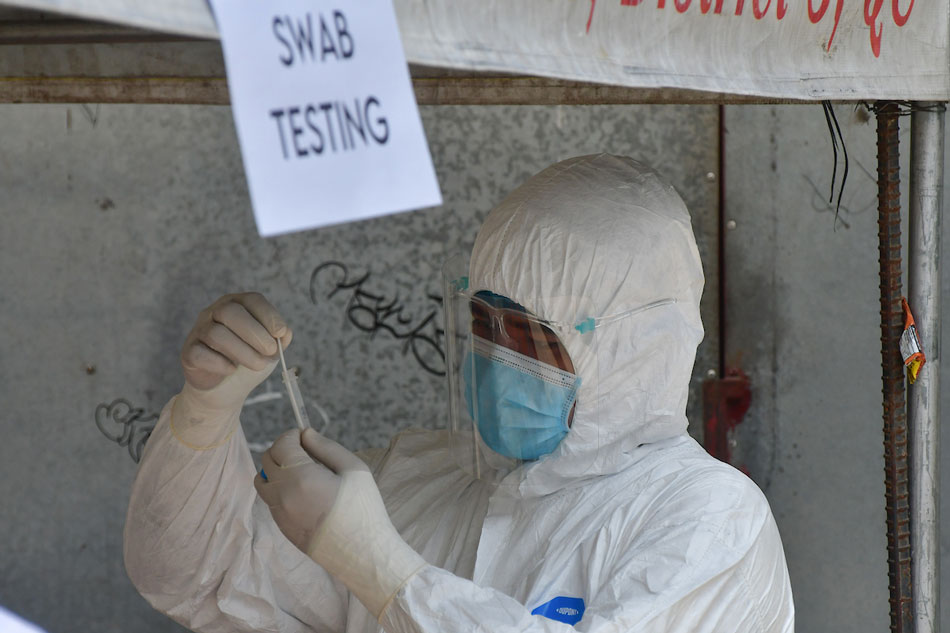NCR may be low-risk for COVID-19 in two weeks: OCTA | ABS-CBN
ADVERTISEMENT

Welcome, Kapamilya! We use cookies to improve your browsing experience. Continuing to use this site means you agree to our use of cookies. Tell me more!
NCR may be low-risk for COVID-19 in two weeks: OCTA
NCR may be low-risk for COVID-19 in two weeks: OCTA
Wena Cos,
ABS-CBN News
Published Jan 31, 2022 02:42 PM PHT
MANILA - The National Capital Region may record fewer than 1,000 daily COVID-19 cases by mid-February, according to OCTA Research on Monday, which may bring its moderate-risk classification one rung down to low-risk.
MANILA - The National Capital Region may record fewer than 1,000 daily COVID-19 cases by mid-February, according to OCTA Research on Monday, which may bring its moderate-risk classification one rung down to low-risk.
"The worst is probably over for most of the country because cases have peaked or are peaking," OCTA's Guido David said in an online forum.
"The worst is probably over for most of the country because cases have peaked or are peaking," OCTA's Guido David said in an online forum.
The University of the Philippines (UP) Pandemic Response Team also said Sunday that new daily infections in Metro Manila are declining, with the group's Jomar Rabajante saying, "Baka mag-less than 1,000 [cases] tayo in February."
The University of the Philippines (UP) Pandemic Response Team also said Sunday that new daily infections in Metro Manila are declining, with the group's Jomar Rabajante saying, "Baka mag-less than 1,000 [cases] tayo in February."
(We may even reach less than 1,000 new cases in February.)
(We may even reach less than 1,000 new cases in February.)
ADVERTISEMENT
RELATED VIDEO
David said heavily-populated areas such as Cebu and Baguio have already recorded a decline in cases.
David said heavily-populated areas such as Cebu and Baguio have already recorded a decline in cases.
Meanwhile, the areas that are still on an upward trend include Bukidnon, Camiguin, Cotabato, Davao De Oro, Davao del Norte, Davao Occidental, Davao Oriental, Maguindanao, Negros Occidental, Sarangani, South Cotabato, and Sultan Kudarat.
Meanwhile, the areas that are still on an upward trend include Bukidnon, Camiguin, Cotabato, Davao De Oro, Davao del Norte, Davao Occidental, Davao Oriental, Maguindanao, Negros Occidental, Sarangani, South Cotabato, and Sultan Kudarat.
"The surge happened later in these provinces, that's why they are still at an accelerating stage," David explained.
"The surge happened later in these provinces, that's why they are still at an accelerating stage," David explained.
"The surge has already matured and is now on a downward trend in many other provinces especially in Visayas and Luzon," he added.
"The surge has already matured and is now on a downward trend in many other provinces especially in Visayas and Luzon," he added.
But David clarified that the overall number of cases nationwide may not be affected by the upward trend in provinces that have yet to peak.
But David clarified that the overall number of cases nationwide may not be affected by the upward trend in provinces that have yet to peak.
ADVERTISEMENT
"Kasi konti na lang sila. Kumabaga mas maraming pababa na, kaysa yung pataas. Yung pataas ay konti na lang. Based sa overall numbers, probably by February, Valentine's, we'll be down to 10,000 cases per day in the entire country, and lower by the end of the month," he said.
"Kasi konti na lang sila. Kumabaga mas maraming pababa na, kaysa yung pataas. Yung pataas ay konti na lang. Based sa overall numbers, probably by February, Valentine's, we'll be down to 10,000 cases per day in the entire country, and lower by the end of the month," he said.
(There are fewer provinces on an upward trend than those with decreasing cases.)
(There are fewer provinces on an upward trend than those with decreasing cases.)
Lawmakers have criticized OCTA Research for the accuracy of its COVID-19 projections. The group said it uses data from the Department of Health.
Lawmakers have criticized OCTA Research for the accuracy of its COVID-19 projections. The group said it uses data from the Department of Health.
Since late December, the Philippines has seen a quick rise in new COVID-19 cases, a wave of infections driven by the highly contagious omicron variant.
Since late December, the Philippines has seen a quick rise in new COVID-19 cases, a wave of infections driven by the highly contagious omicron variant.
As of Sunday, exactly two years since it confirmed its first COVID-19 case, the country has recorded a total of 3,545,680 infections after logging an additional 16,953.
As of Sunday, exactly two years since it confirmed its first COVID-19 case, the country has recorded a total of 3,545,680 infections after logging an additional 16,953.
ADVERTISEMENT
Almost 58.8 million people in the Philippines have been fully vaccinated against the respiratory illness, while more than 60.3 million others have received their first dose. Over 7.3 million booster doses have also been administered.
Almost 58.8 million people in the Philippines have been fully vaccinated against the respiratory illness, while more than 60.3 million others have received their first dose. Over 7.3 million booster doses have also been administered.
Read More:
pandemic
COVID-19
covid
OCTA research
OCTA
omicron
coronavirus
Guido David
Metro Manila
National Capital Region
ADVERTISEMENT
ADVERTISEMENT



